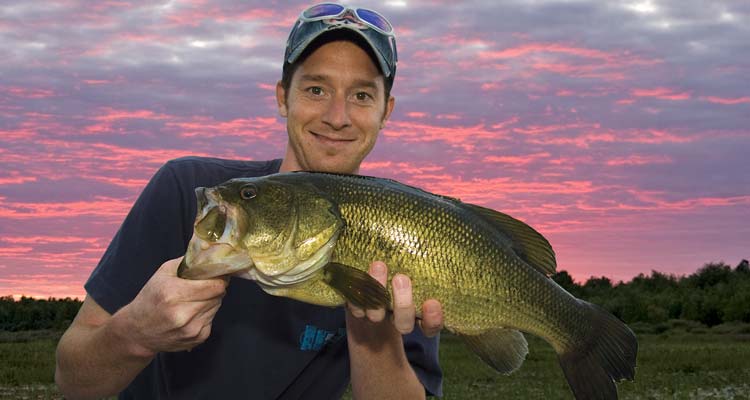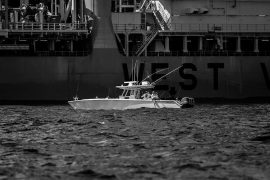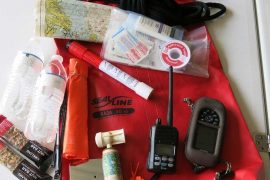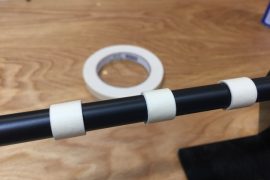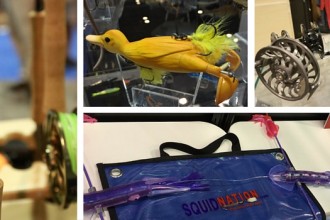
Go shallow during low-light periods for excellent late-summer largemouth bass action.
As I sit with my brother, Jeff, in the living room, he tells me about a grueling work contract he just finished. I quickly determine he is in need of fresh air and hook-set therapy, so instead of chewing the fat on the couch, I suggest we go fishing.
It’s 2 p.m. by the time we navigate our way into the giant backwater lake well away from the main river channel. It’s a largemouth paradise filled with pads, milfoil, cane, reeds, and flooded timber. Dragonflies and birds buzz around while baitfish, sunfish, and frogs splash on the surface. If I was a largemouth, I’d live here.
It doesn’t take long for us to start catching largemouth on Texas-rigged stickbaits, flipping jigs, and topwater frogs. But, as dusk approaches, the fishing goes from good to blow-your-mind awesome. Bass are going berserk and chasing our topwater frogs with incredible ferocity.
At one point, I wedge the trolling motor and boat against a sunken tree so we can cast hollow-bellied frogs 360 degrees. Bass strike from every direction.
It is an incredible night and just what Jeff needed after too much work and not enough down time. In addition to the fun bonding with my bro, the night stands out as a reminder of how low-light periods, such as dusk and dawn, often produce excellent largemouth bass action.

Low-Light Largemouth
As a warm-water species, largemouth bass like it hot. Consistent, stable summer weather spurs them to feed, which is good news.
Light intensity is an important factor, though. When you’re wearing sunglasses to stop squinting, largemouth are likely hanging in the shade for relief from the sun’s rays. Docks, overhead timber, sunken tree stumps, and canopies of thick vegetation are areas largemouth tuck under when it’s sunny. Flipping a jig or running a crankbait around these shadowy spots catches bass in these scenarios.
As the day ends, the sun’s angle shifts, and light becomes less intense. The entire food web gets active. Bass tucked tight to cover in the day actively hunt and roam come evening. It’s one of the best times to fish for them in summer.
What follows are three reliable strategies for catching largemouth in low light. While many lures catch bass during the bookends of the day, topwater and subsurface baits are the most consistent. Positioned high in the water column, bass can locate these lures’ silhouettes in fading light.
Froggin’ Around Floating Vegetation
If I had to pick one spot to chase largemouth in low light, it’d be emergent and floating vegetation. Lily pads, rice, arrowheads, slop, clumps of weeds—the list goes on. This greenery is prime turf for prowling largemouth during low light because baitfish, frogs, salamanders, rodents, birds, and bugs all live in these marshy areas.

Generally, the bigger the area, the better because it gives more square footage for bass to live. More space can mean better numbers and larger fish. Backwater areas in large rivers are prime locations; in lakes, look to large bays and coves. The property value increases when a tributary is present because current keeps oxygen and nutrients flowing into the area.
Focus efforts on points and bends in the vegetation, which act as travel corridors for bass moving in and out of the weeds. Expect active fish to be on the outer edge and watch for patches of isolated cover. It may seem counterintuitive, but big bass often hold under small, remote pieces of vegetation or timber. Open pockets within mats of weeds are also prime casting targets.
A hollow-belly frog is a top pick for fishing these spots. Popular choices include the Booyah Pad Crasher Frog, Jackall Iobee Frog, Lunkerhhunt Lunker Frog, LiveTarget Hollow Body Frog, Reaction Innovations Swamp Donkey, Snag Proof Bobby’s Perfect Frog, Spro Dean Rojas Bronzeye Frog, and Terminator Walking Frog. A soft-plastic toad Texas-rigged with a wide-gap, offset hook is an appropriate alternative.
Being weedless, frogs run through thick cover well. This lets an angler cast a frog on shore, then slip in the water with a gentle splash–a maneuver that fools big bass.
A frog also “matches the hatch,” so to speak. It’s a Kermit copycat, but also decoys other surface-swimming snacks such…

